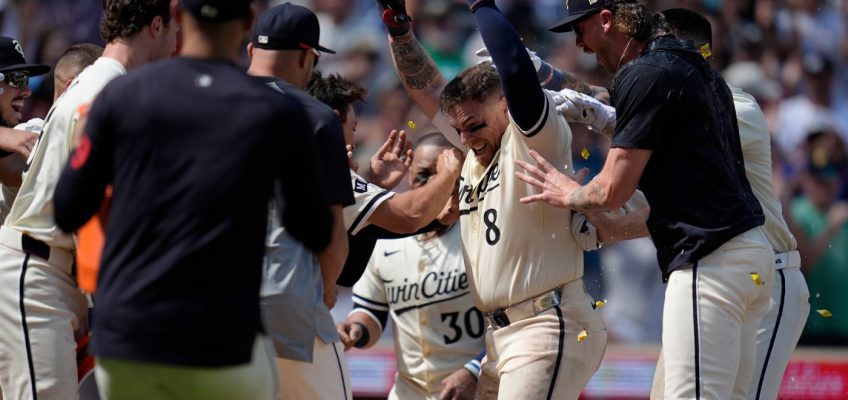As Christian Vázquez made his way into the visitor’s clubhouse last Thursday at Globe Life Field in Arlington, Texas, bat in hand, a seven-person Puerto Rican band played jubilant music.
The live band was just one part of an elaborate surprise for Vázquez, arranged by his wife Gaby, to honor the veteran for his 10 years of major league service time, a milestone that less than 10 percent of players in Major League Baseball history have reached. Vázquez and his teammates quickly got in the groove, dancing to the music as they toasted his accomplishment.
There’s a lot to celebrate right now in Christian Vázquez’s world. He had a birthday on Wednesday, turning 34, he and Gaby are set to welcome their third child to this world next month, and he’s completely turned his season around at the plate after a difficult first few months to begin the year.
“Whatever he’s doing, he looks great,” Twins manager Rocco Baldelli said. “And we’ll take it. He’s helping us score runs. Coming from where he is in the lineup, that’s huge. And, he’s never wavered defensively at any point.”
While he always has been an asset behind the plate, Vázquez’s offensive start to the season couldn’t have been much worse. Through the first three months of the season, he was hitting .181 with a .207 on-base percentage and .252 slugging percentage. He had just seven extra-base hits through the end of June.
Behind the scenes, he was putting in plenty of work — assistant hitting coach Derek Shomon referred to him as a “known tinkerer” — searching for results that didn’t come for quite some time.
“(There was) definitely for sure frustration, for sure frustration. Pissed off at me, and I’m pissed off at him and we’re getting into it, and that’s what happens with adult males in a high-stress industry,” Shomon said. “In Major League Baseball, you’ve got to perform, and so he was definitely frustrated because he knew he could perform better. He knew he was better than what he was showing.”
Finally, at long last, the duo found something that worked. They made a tweak with his upper body and they also simplified his cage routine. Where his routine used to be upwards of near a half an hour, now it might be under 10 minutes.
“It (is) in and out in a couple swings and I feel the feeling that I’m feeling right now. and that’s it,” Vázquez said.
Once they simplified things, Shomon said, things started to click. It translated into game performance, where the catcher started to turn his season around in early July.
He knew it was working when he started to see the results.
“The first week of July, I was consistent every game,” Vázquez said.
Since that point, Vázquez is hitting .338 with a .365 on-base percentage and .575 slugging percentage. He has five home runs among his 27 hits in those 26 games.
One of those hits was a pinch-hit, two-run single that lifted the Twins to an eighth-inning lead on Tuesday night after they had surrendered their advantage a half inning earlier. It was a huge moment for him, though the Twins eventually lost the game to the San Diego Padres.
It’s rewarding for Vázquez, of course, but also for Shomon, who put in so many hours with him in the cage trying to help him turn things around.
“We, as coaches, I think at times feel their struggle more than they do and want it so bad for them, especially when you see things trending in the right direction in all areas leading up until game time,” Shomon said. “You’re just hoping and wanting it to carry over, especially when you’re making an adjustment. … (I’m) elated, right, and more so just happy with how consistent he has been.”
It’s been nearly two months of consistency now for the veteran catcher, who has moved past the frustration of the early season into the celebratory days of August.
“It was hard,” Vázquez said. “It was hard obviously because I was trying to help the team on both sides and it was not working, but now it feels good.”
Twins break out the bats in win over Padres
Ryan Jeffers becomes just fourth Twins catcher to reach this milestone
Second bullpen blowup in three days sends Twins to loss in San Diego
Saints’ Morris is latest prospect in Twins’ arms race
Carlos Correa, Byron Buxton progressing but no timeline for injured Twins stars




